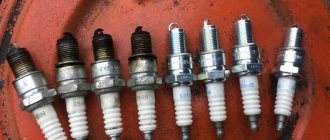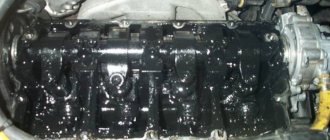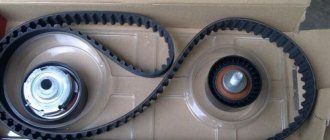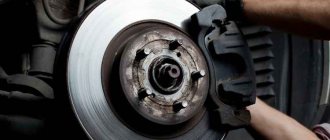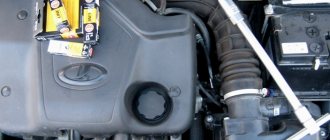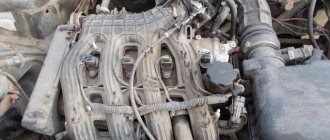The production of a domestic modification of the Lada Granta has been carried out for several years. The car has gained significant credibility due to its acceptable quality and level of performance, as well as the presence of several different configuration versions.
Today we’ll figure out when to change the timing belt, as well as which timing belt is better.
Causes of timing belt wear
The main reason why it is necessary to regularly replace the belt is natural wear. During vehicle operation, the belt moves at high speed along metal rollers, pulleys and guides, being under high tension.
At the same time, the belt is subjected to additional loads, which significantly increase wear:
- high temperature changes in the engine compartment (up to 100 degrees in winter);
- beating in case of wear of the tensioning mechanism;
- short-term loads due to internal combustion engine friction, uneven movement of valve pushers, changes in clearance values;
- liquids, contaminants and oils getting on the timing belt;
- random objects rubbing against the surface of the belt (casing, wires, fastening elements).
The cause of premature belt failure can be serious mechanical malfunctions of the engine:
- damage to the crank mechanism;
- jamming of valves and piston group;
- damage to the camshaft, rollers;
- wear of the crankshaft and camshaft guide pins.
If we take into account all the risks that arise during the operation of the belt, it is advisable to artificially reduce the resource declared by the manufacturer by 20 - 30%.
One of the reasons for premature wear: inadequate quality. Since the timing belt is an important component, you should not skimp on a dubious manufacturer and seller.
Some general provisions about the belt
The timing belt in any engine serves to ensure timely intake of the prepared mixture and release of exhaust gases. The composition of this node implies the presence of the following elements:
- camshaft and crankshaft;
- the valves themselves with seals, springs, guide bushings and other parts.
Which timing belt is better? The belt mechanism is positioned separately in this mechanism, acting as a connecting link between the camshaft (or two) and the crankshaft. It is the belt drive that is able to ensure synchronization in the functioning of the elements included in the timing kit.
Signs of critical belt wear
Signs of wear are distinguished: direct and indirect.
Direct signs of wear include:
- presence of cracks on the belt surfaces (external and internal);
- chips on the inner surfaces of the teeth;
- longitudinal sections on the outer surface;
- presence of heavy contamination;
- visible runout and stretching of the timing belt;
- extreme cases - belt breakage, “licking” of teeth.
The listed signs can be detected by visual inspection. In most cases, this requires removing the belt cover. In some car models, this requires “hanging” the engine and carrying out a series of dismantling works. Therefore, before deciding to diagnose the condition of the belt drive, it is necessary to evaluate indirect signs of wear, which include:
- misfires in engine cylinders;
- detonation, especially at the moment of shutdown;
- uneven idle speed.
These signs can be examined using computer diagnostics. The most effective diagnostic result is achieved by studying the ignition angle in dynamic mode (with the engine running). Typically it should be within plus or minus five degrees. In this case, the ignition timing when the engine rotates at idle speed should not change significantly.
Timing for replacing timing belts
When the question is raised about the frequency of belt replacement, first of all, we mean the maximum period during which the belt retains its properties. At the same time, the probability of its stretching and breaking, which can lead to serious damage, is calculated.
There are special programs (AUTODATA, ELSA and others) that clearly establish the timing of routine maintenance, including the replacement of belts and rollers. However, these programs do not take into account the operating conditions of the car and available components. Ordinary drivers and most non-dealer service stations are guided by the established operating life and mileage of the car. It's better to judge by mileage. Many people estimate the period for mandatory belt replacement based on mileage to range from 50,000 to 80,000. However, if the car is used little, its annual mileage is, for example, 5,000 per year, this does not mean that the belt must be replaced every 10 years. The maximum service life of a car without replacing the timing belt is usually 5 - 7 years (subject to mileage conditions).
It is also necessary to take into account the characteristics of the engines. If the engine has two camshafts, there are more valves, and accordingly, greater loads are placed on the belt.
At the same time, the tension roller (or mechanism) and guides should be changed along with the timing belt. In most cases, adjustment of the ignition angle is required. Modern engine control systems block engine starting if the ignition angle is incorrect. This is done to ensure that when setting the wrong angle, accidental starting and destruction of the timing system does not occur.
When determining the timing of belt replacement, it is necessary to take into account operating conditions and vehicle mileage. If the machine is operated in conditions of extremely low or high ambient temperatures, the replacement period must be reduced by 10 - 15%.
In order to reduce the likelihood of abnormal timing belt damage, you should:
- monitor the integrity of the protective casing;
- do not allow foreign liquids, oils, or objects to get into the belt area;
- observe the frequency of routine maintenance.
Some tips on the replacement procedure
If you set out to replace the component yourself, then you should not neglect some of the recommendations below. In particular, do not forget to observe the interval at which you change the timing belt.
After hanging the belt, its correct tension is required. This is done through the use of a specialized key. Some “figures” will object, they say, we can do without it. However, here it is very problematic to dare to guarantee a high-quality result. The force applied to the belt branch (when rotated at a 90-degree angle), located between two shafts (well-known: camshaft and crankshaft), should not exceed 20 Nm, but it should not be less than 15 Nm. If there is no “fall” within the designated parameter range, this indicates incorrect belt tension. There is only one consequence - a new regulation!
general information
Most often, the timing mechanism is located in the front of the car; in older car models it can be found between the engine cylinder and the radiator. Today, manufacturers are trying to reliably hide the part, however, to find it, you just need to unscrew the protection and start repairing. The composition of the element is a rubber mixture. Many manufacturers use highly saturated nitrile, which provides excellent wear resistance at high temperatures. There are teeth on the inside. Manufacturers produce their own type of belts for each car model.
A broken belt will cause many problems for your car. The whole point is that the part uses basic systems. When it breaks, the shaft freezes in one position. The pistons continue to move, hitting the valves and deforming them. The consequences can be dire.
The main reasons for the break:
- An unscrupulously assembled car engine.
- Severely worn mechanism.
- The elasticity of the material has deteriorated significantly - rupture occurs.
- Poor quality workmanship of the part.
- Pump rollers are not tensioned well.
What are the expected consequences of a break?
As stated, no problems with the Lada Granta engine in the 8-valve version, or if the belt drive breaks, arise only in the version of the “11183-50” unit. The remaining engines are at risk of failure in the event of a designated unpleasant incident. In view of this, a dispute arose among the “Grantavods” regarding the advantages of LADA Granta engines with 16 and 8 valves, and which unit has more of them. Your point of view will also be very interesting.
If the belt drive breaks, the camshaft stops in the position corresponding directly to the moment of failure. In contrast, the crankshaft is subject to continued rotation. This causes the pistons to hit the valves that were in the open position at a given moment. Then the latter bend, but sometimes a breakdown of the piston bottom occurs. Popularly called “fist of friendship”!
It is based on this fact that experts are inclined to recommend changing the timing kit before the period stated by the manufacturer for this action.
Replacement frequency
The timing life is on average 60–80 thousand kilometers. But there are cases when belts run both 150,000 km and 30 thousand km. For each vehicle, the resource is determined in the manufacturer’s service data. We recommend focusing on this information.
But also remember that difficult operating conditions of the car significantly reduce the timing life. In fact, if the vehicle is driven on bad roads, the value of the numbers decreases. The fact is that manufacturers test cars at testing grounds, and if you drive through city traffic jams every day, the mechanism of the car has a more negative impact. Among other things, bad weather conditions also affect the service life.
The degree of wear of the gas distribution mechanism is most influenced by the mileage of the vehicle. Different car models have their own meaning. Rapid wear of a part can be associated with bad roads, mud, and frequent city traffic jams. Manufacturers recommend changing the element after 50–60 thousand kilometers. Often car owners also change the rollers. The fact is that if the roller stops (jams), then the new part will become unusable. Problems may also arise with other vehicle mechanisms.
Inspection
The mechanism must be inspected every 20,000 km. During the inspection, it is necessary to pay special attention to contamination of the mechanism (dust, dirt, oil, antifreeze). If debris is found under the belt cover, it is necessary to remove all dirt, and if there are traces of oil or antifreeze on the belt, it is recommended to replace it soon.
The belt should be free of cracks, chips and tears, and there should be no threads sticking out of it.
The rollers should not make noise or creaks, the plastic on them should be smooth without cracks.
The water pump (pump) should not have any play or leakage of coolant.
Tips on how to increase resource
- Warm up the engine before driving in cold weather.
- When replacing, also change the rollers and pump, following the manufacturers' recommendations.
- Buy spare parts from trusted brands, check whether you have purchased a counterfeit.
While writing the article, I was able to find statistics on the mileage at which the belt broke on cars. The statistics are as follows:
Of course, the data is difficult to analyze, since neither the car brands nor the operating conditions are known. In general, we can conclude: check whether the timing belt on your car has reached the end of its life, replace it in proven places and do not skimp on spare parts.
How to choose a quality spare part
The Lada Granta timing belt plays a primary role in engine operation, so you need to choose it carefully. During movement, this part can withstand enormous loads, and it must be of the highest quality. Today, there are several proven manufacturers whose products deserve high marks. The most famous and good timing belts for Granta brands: • Contitech • Gates • Dayco • Bosch Among domestic manufacturers, one can highlight the BalakovoRezinotekhnika (BRT) company, which provides Granta timing belt life and an affordable price.
For ease of selection for a 16-valve Grant, you can use the following table:
| Brand | Catalog number |
| BRT | 2112-61006040 |
| Lynx | 137FL22 |
| Conti | CT1137 |
| Bosch | 1987949662 |
| Gates | 5631XS |
| Contitech | CT1137 |
| Dayco | KTB944 |
When purchasing products from a well-known company, every driver thinks about which timing belt is best for Grant. But besides this, the car owner must be careful not to fall for a fake. It is necessary to check the presence of holograms and other identification marks used by a particular company, as well as the coincidence of the original part number and the inscription on the box.
You should buy spare parts only from trusted retail outlets, which bear full responsibility for the quality of the products sold.
Reviews
I changed the belt at 100 thousand km, leaving the old rollers. As a result, 130 thousand km. The bearings fell apart and the belt broke.
The timing belt was changed at 80 thousand km, the condition was acceptable. But I drive on harsh roads and, in order to avoid problems with valves, etc., I decided to change them in advance. The manufacturer's regulations are 120 thousand km.
After buying the car, the first factory belt was changed after 61 thousand km, it was changed by the officials. I asked them to show me the old belt and didn't notice any wear on it at all.
Recommendations from Lada Granta owners
Many Lada Granta owners, especially those equipped with 16-valve versions of power units, recommend not waiting for the coveted 60 thousand km mark. This is due to the possibility of using low-quality components, which can cause wear of the replaced elements after a mileage of 20 thousand km.
This fact encourages many “Grantavods” to resort to using products with good quality, and many of them, when asked which timing belt is better, answer that from . But we note that there are counterfeits of spare parts of this brand, and therefore it is recommended to purchase items only from trusted suppliers.


